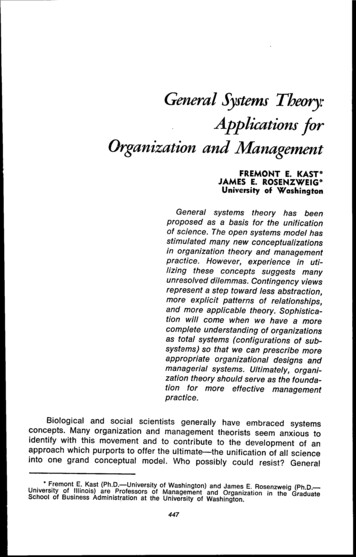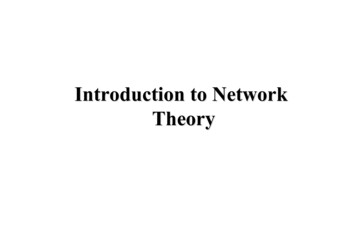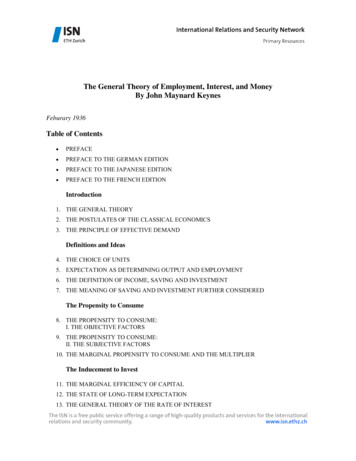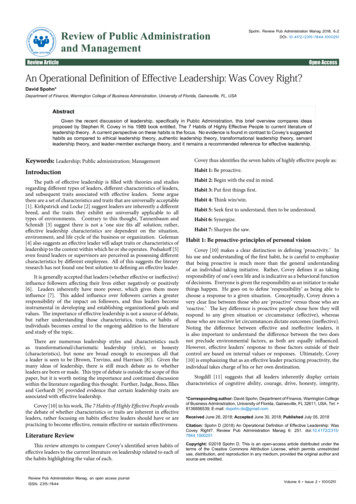
Transcription
General Systems Theory:Applications forOrganization and ManagementFREMONT E, KAST*JAMES E. ROSENZWEIG*University of WoshingtonGeneral systems theory has beenproposed as a basis for the unificationof science. The open systems model hasstimulated many new conceptualizationsin organization theory and managementpractice. However, experience in utilizing these concepts suggests manyunresolved dilemmas. Contingency viewsrepresent a step toward less abstraction,more explicit patterns of relationships,and more applicable theory. Sophistication will come when we have a morecomplete understanding of organizationsas total systems (configurations of subsystems) so that we can prescribe moreappropriate organizational designs andmanagerial systems. Ultimately, organization theory should serve as the foundation for more effective managementpractice.Biological and social scientists generally have embraced systemsconcepts. Many organization and management theorists seem anxious toidentify with this movement and to contribute to the development of anapproach which purports to offer the ultimate—the unification of all scienceinto one grand conceptual model. Who possibly could resist? General* Fremont E. Kast (Ph.D.—University of Washington) and James E. Rosenzweig (Ph D —University of iiinois) are Professors of Management and Organization in the GraduateSchool of Business Administration at the University of Washington.447
448Academy of Management JournalDecembersystems theory seems to provide a relief from the limitations of moremechanistic approaches and a rationale for rejecting "principles" basedon relatively "closed-system" thinking. This theory provides the paradigmfor organization and management theorists to "crank into their systemsmodel" all of the diverse knowledge from relevant underlying disciplines.It has become almost mandatory to have the word "system" in the titleof recent articles and books (many of us have compromised and placed itonly in the subtitle). But where did it all start? This question takes us back into historyand brings to mind the long-standing philosophical arguments betweenmechanistic and organismic models of the 19th and early 20th centuries.As Deutsch says:Both mechanistic and organismic modeis were based substantially on experiencesand operations known before 1850. Since then, the experience of aimost a centuryof scientific and technoiogical progress has so far not been utilized for any significant new model for the study of organization and in particular of human thought[12, p. 389].General systems theory even revives the specter of the "vitalists" andtheir views on "life force" and most certainly brings forth renewed questionsof teleological or purposeful behavior of both living and nonliving systems.Phillips and others have suggested that the philosophical roots of generalsystems theory go back even further, at least to the German philosopherHegel (1770-1831) [29, p. 56]. Thus, we should recognize that in the adoptionof the systems approach for the study of organizations we are not dealingwith newly discovered ideas— they have a rich genealogy.Even in the field of organization and management theory, systemsviews are not new. Chester Barnard used a basic systems framework.A cooperative system is a compiex of physical, biological, personal, and socialcomponents which are in a specific systematic relationship by reason of thecooperation of two or more persons for at least one definite end. Such a systemis evidentiy a subordinate unit of iarger systems from one point of view; anditself embraces subsidiary systems—physical, biological, etc.—from another pointof view One of the systems comprised within a cooperative system, the one whichis implicit in the phrase "cooperation of two or more persons," is called an"organization" [3, p. 65j.And Barnard was influenced by the "systems views" of Vilfredo Pareto andTalcott Parsons. Certainly this quote (dressed up a bit to give the term"system" more emphasis) could be the introduction to a 1972 book onorganizations.Miller points out that Alexander Bogdanov, the Russian philosopher,developed a theory of tektology or universal organization science in 1912which foreshadowed general systems theory and used many of the sameconcepts as modern systems theorists [26, p. 249-250].lAn entire article could be devoted to a discussion of ingenious ways in which theterm "systems approach" has been used in the literature pertinent to organization theoryand management practice.
Theory: Applications for Organization and Management449However, in spite of a long history of organismic and holistic thinking,the utilization of the systems approach did not become the accepted modelfor organization and management writers until relatively recently. It isdifficult to specify the turning point exactly. The momentum of systemsthinking was identified by Scott in 1961 when he described the relationshipbetween general systems theory and organization theory.The distinctive qualities of modern organization theory are its conceptualanalytical base, its reliance on empirical research data, and above all, its integrating nature. These qualities are framed in a philosophy which accepts thepremise that the only meaningful way to study organization is to study it as asystem . . . Modern organization theory and general system theory are similarin that they look at organization as an integrated whole [33, pp. 15-21].Scott said explicitly what many in our field had been thinking and/orimplying—he helped us put into perspective the important writings ofHerbert Simon, James March, Talcott Parsons, George Homans, E. WightBakke, Kenneth Boulding, and many others.But how far have we really advanced over the past decade in applyinggeneral systems theory to organizations and their management? Is it stilla "skeleton," or have we been able to "put some meat on the bones"? Thesystems approach has been touted because of its potential usefulness inunderstanding the complexities of "live" organizations. Has this approachreally helped us in this endeavor or has it compounded confusion withchaos? Herbert Simon describes the challenge for the systems approach:In both science and engineering, the study of "systems" is an increasingly popular activity. Its popularity is more a response to a pressing need for synthesizinqand analyzing complexity than it is to any large development of a body of knowledge and technique for dealing with complexity. If this popularity is to be morethan a fad, necessity will have to mother invention and provide substance to qowith the name [35, p. 114].In this article we will explore the issue of whether we are providingsubstance for the term systems approach as it relates to the study of organizations and their management. There are many interesting historical andphilosophical questions concerning the relationship between the mechanisticand organistic approaches and their applicability to the various fields ofscience, as well as other interesting digressions into the evolution of systems approaches. However, we will resist those temptations and plungedirectly into a discussion of the key concepts of general systems theory,the way in which these ideas have been used by organization theorists, thelimitations in their application, and some suggestions for the future.KEY CONCEPTS OF GENERAL SYSTEMS THEORYThe key concepts of general systems theory have been set forth bymany writers [6, 7, 13, 17, 25, 28, 39] and have been used by many organization and management theorists [10, 14, 18, 19, 22, 23, 24, 32]. It is notour purpose here to elaborate on them in great detail because we anticipatethat most readers will have been exposed to them in some depth. Figure I
450Academy of Management JournalDecemberprovides a very brief review of those characteristics of systems whichseem to have wide acceptance. The review is far from complete. It is diffiFIGURE IKey Concepts of General Systems TheorySubsystems or Comporients: A system by definition is composed of interrelated parts orelements. This is true for all systems—mechanical, biological, and social. Every system hasat least two elements, and these elements are interconnected.Holism, Synergism, Organicism, and Gestait: The whole is not just the sum of the parts;the system itself can be explained only as a totality. Holism is the opposite of elementarism,which views the total as the sum of its individual parts.Open Systems View: Systems can be considered in two ways: (1) closed or (2) open. Opensystems exchange information, energy, or material with their environments. Biological andsocial systems are inherently open systems; mechanical systems may be open or closed.The concepts of open and closed systems are difficult to defend in the absolute. We preferto think of open-closed as a dimension; that is, systems are relatively open or relativelyclosed.Input-Transformation-Output Model: The open system can be viewed as a transformationmodel. In a dynamic relationship with its environment, it receives various inputs, transformsthese inputs in some way, and exports outputs.System Boundaries: It follows that systems have boundaries which separate them fromtheir environments. The concept of boundaries helps us understand the distinction betweenopen and closed systems. The relatively closed system has rigid, impenetrable boundaries;whereas the open system has permeable boundaries betvyeen itself and a broader suprasystem. Boundaries are relatively easily defined in physical and biological systems, butare very difficult to delineate in social systems, such as organizations.Negative Entropy: Closed, physical systems are subject to the force of entropy whichincreases until eventually the entire system fails. The tendency toward maximum entropyis a movement to disorder, complete lack of resource transformation, and death. In aclosed system, the change in entropy must always be positive; however, in open biologicalor social systems, entropy can be arrested and may even be transformed into negativeentropy—a process of more complete organization and ability to transform resources—because the system imports resources from its environment.Steady State, Dynamic Equiiibrium, and Homeostasis: The concept of steady state is closelyrelated to that of negative entropy. A closed system eventually must attain an equilibriumstate with maximum entropy—death or disorganization. However, an open system mayattain a state where the systenti remains in dynamic equilibrium through the continuous Inflow of materials, energy, and information.Feedback: The concept of feedback is important in understanding how a systeni maintainsa steady state. Information concerning the outputs or the process of the system is fed backas an input into the system, perhaps leading to changes in the transformation processand/or future outputs. Feedback can be both positive and negative, although the field ofcybernetics is based on negative feedback. Negative feedback is informational input whichindicates that the system is deviating from a prescribed course and should readjust to anew steady state.Hierarciiy: A basic concept in systems thinking is that of hierarchical relationships betweensystems. A system is composed of subsystems of a lower order and is also part of a suprasystem. Thus, there is a hierarchy of the components of the system.Internal Elaboration: Closed systems move toward entropy and disorganization. In contrast,open systems appear to move in the direction of greater differentiation, elaboration, and ahigher level of organization.Multiple Goal-Seeking: Biological and social systenns appear to have multiple goals orpurposes. Social organizations seek multiple goals, if for no other reason than that theyare composed of individuals and subunits with different values and objectives.Equifinaiity of Open Systems: In mechanistic systems there is a direct cause and effectrelationship between the initial conditions and the final state. Biological and social systemsoperate differently. Equifinality suggests that certain results may be achieved with differentinitiai conditions and in different ways. This view suggests that social organizations canaccomplish their objectives with diverse inputs and with varying internal activities (conversion processes).
Ttieory: Appiications for Organization and Management4S1cult to identify a "complete" list of characteristics derived from generalsystems theory; moreover, it is merely a first-order classification. Thereare many derived second- and third-order characteristics which could beconsidered. For example, James G. Miller sets forth 165 hypotheses, stemming from open systems theory, which might be applicable to two or morelevels of systems [25]. He suggests that they are general systems theoreticalhypotheses and qualifies them by suggesting that they are propositionsapplicable to general systems behavior theory and would thus exclude nonliving systems. He does not limit these propositions to individual organisms,but considers them appropriate for social systems as well. His hypothesesare related to such issues as structure, process, subsystems, information,growth, and integration. It is obviously impossible to discuss all of thesehypotheses; we want only to indicate the extent to which many interestingpropositions are being posed which might have relevance to many differenttypes of systems. It will be a very long time (if ever) before most of thesehypotheses are validated; however, we are surprised at how many of themcan be agreed with intuitively, and we can see their possible verificationin studies of social organizations.We turn now to a closer look at how successful or unsuccessful wehave been in utilizing these concepts in the development of "modernorganization theory."A BEGINNING: ENTHUSIASTIC BUT INCOMPLETEWe have embraced general systems theory but, really, how completely?We could review a vast literature in modern organization theory which hasexplicitly or implicitly adopted systems theory as a frame of reference,and we have investigated in detail a few representative examples of theliterature in assessing the "state of the art" [18, 19, 22, 23, 31, 38]. It wasfound that most of these books professed to utilize general systems theory.Indeed, in the first few chapters, many of them did an excellent job ofpresenting basic systems concepts and showing their relationship toorganizations; however, when they moved further into the discussion ofmore specific subject matter, they departed substantially from systemstheory. The studies appear to use a "partial systems approach" and leavefor the reader the problem of integrating the various ideas into a systemicwhole. It also appears that many of the authors are unable, because oflimitations of knowledge about subsystem relationships, to carry out thetask of using general systems theory as a conceptual basis for organizationtheory.Furthermore, it is evident that each author had many "good ideas"stemming from the existing body of knowledge or current research onorganizations which did not fit neatly into a "systems model." For example,they might discuss leadership from a relatively closed-system point of view
452Academy of Management JournalDecemberand not consider it in relation to organizational technology, structure,or other variables. Our review of the literature suggests that much remainsto be done in applying general systems theory to organization theory andmanagement practice.SOME DILEMMAS IN APPLYING GST TO ORGANIZATIONSWhy have writers embracing general systems theory as a basis forstudying organizations had so much difficulty in following through? Partof this difficulty may stem from the newness of the paradigm and our inability to operationalize "all we think we know" about this approach. Orit may be because we know too little about the systems under investigation.Both of these possibilities will be covered later, but first we need to look atsome of the more specific conceptual problems.Organizations as OrganismsOne of the basic contributions of general systems theory was therejection of the traditional closed-system or mechanistic view of socialorganizations. But, did general systems theory free us from this constraintonly to impose another, less obvious one? General systems theory grewout of the organismic views of von Bertalanffy and other biologists; thus,many of the characteristics are relevant to the living organism. It is conceptually easy to draw the analogy between living organisms and socialorganizations. "There is, after all, an intuitive similarity between the organization of the human body and the kinds of organizations men create. Andso, undaunted by the failures of the human-social analogy through time,new theorists try afresh in each epoch" [2, p. 660]. General systems theorywould have us accept this analogy between organism and social organization. Yet, we have a hard time swallowing it whole. Katz and Kahn warnus of the danger:There has been no more pervasive, persistent, and futile fallacy handicapping thesocial sciences than the use of the physical model for the understanding ofsocial structures. The biological metaphor, with its crude comparisons of thephysical parts of the body to the parts of the sociai system, has been replacedby more subtle but equally misleading analogies between biological and socialfunctioning. This figurative type of thinking ignores the essential difference between the socially contrived nature of social systems and the physical structureof the machine or the human organism. So long as writers are committed to atheoretical framework based upon the physical model, they will miss the essentialsociai-psychological facts of the highly variable, loosely articulated characterof sociai systems [19, p. 31].In spite of this warning, Katz and Kahn do embrace much of the generalsystems theory concepts which are based on the biological metaphor. Wemust be very cautious about trying to make this analogy too literal. Weagree with Silverman who says, "It may, therefore, be necessary to dropthe analogy between an organization and an organism: organizations maybe systems but not necessarily natural systems" [34, p. 31].
1972Theory: Applications for Organization and Management453Distinction between Organization and an OrganizationGeneral systems theory emphasizes that systems are organized—theyare composed of interdependent components in some relationship. Thesocial organization would then follow logically as just another system. But,we are perhaps being caught in circular thinking. It is true that all systems(physical, biological, and social) are by definition organized, but are allsystems organizations? Rapoport and Horvath distinguish "organizationtheory" and "the theory of organizations" as follows:We see organization theory as dealing with general and abstract organizationalprinciples; it applies to any system exhibiting organized complexity. As such,organization theory is seen as an extension of mathematical physics or, evenmore generally, of mathematics designed to deal with organized systenis. Thetheory of organizations, on the other hand, purports to be a social science, itputs real human organizations at the center of interest. It may study the socialstructure of organizations and so can be viewed as a branch of sociology; it canstudy the behavior of individuals or groups as members of organizations and canbe viewed as a part of social psychology; it can study power relations and principles of control in organizations and so fits into political science [30, pp. 74-75].Why make an issue of this distinction? It seems to us that there is avital matter involved. All systems may be considered to be organized, andmore advanced systems may display differentiation in the activities ofcomponent parts—such as the specialization of human organs. However,all systems do not have purposeful entitles. Can the heart or lungs be considered as purposeful entities in themselves or are they only componentsof the larger purposeful system, the human body? By contrast, the socialorganization is composed of two or more purposeful elements. "An organization consists of elements that have and can exercise their own wills"[1, p. 669]. Organisms, the foundation stone of general systems theory, donot contain purposeful elements which exercise their own will. This distinction between the organism and the social organization is of importance.In much of general systems theory, the concern is primarily with the wayin which the organism responds to environmentally generated inputs. Feedback concepts and the maintenance of a steady state are based on internaladaptations to environmental forces. (This is particularly true of cyberneticmodels.) But, what about those changes and adaptations which occur fromwithin social organizations? Purposeful elements within the social organization may initiate activities and adaptations which are difficult to subsumeunder feedback and steady state concepts.Opened and Closed SystemsAnother dilemma stemming from general systems theory is the tendencyto dichotomize all systems as opened or closed. We have been led to thinkof physical systems as closed, subject to the laws of entropy, and to thinkof biological systems as open to their environment and, possibly, becoming negentropic. But applying this strict polarization to social organizations creates many difficulties. In fact, most social organizations and theirsubsytems are "partially open" and "partially closed." Open and closed
454Academy of Management JournalDecemberare a matter of degree. Unfortunately, there seems to be a widely heldview (often more implicit than explicit) that open-system thinking is goodand closed-system thinking is bad. We have not become sufficiently sophisticated to recognize that both are appropriate under certain conditions.For example, one of the most useful conceptualizations set forth byThompson is that the social organization must seek to use closed-systemconcepts (particularly at the technical core) to reduce uncertainty and tocreate more effective performance at this level.Still Subsystems ThinkingEven though we preach a general systems approach, we often practicesubsystems thinking. Each of the academic disciplines and each of uspersonally have limited perspective of the system we are studying. Whileproclaiming a broad systems viewpoint, we often dismiss variables outsideour interest or competence as being irrelevant, and we only open oursystem to those inputs which we can handle with our disciplinary bag oftools. We are hampered because each of the academic disciplines hastaken a narrow "partial systems view" and find comfort in the relativecertainty which this creates. Of course, this is not a problem unique tomodern organization theory. Under the more traditional process approachto the study of management, we were able to do an admirable job of delineating and discussing planning, organizing, and controlling as separateactivities. We were much less successful in discussing them as integratedand interrelated activities.How Does Our Knowledge Fit?One of the major problems in utilizing general systems theory is thatwe know (or think we know) more about certain relationships than we canfit into a general systems model. For example, we are beginning to understand the two-variable relationship between technology and structure. But,when we introduce another variable, say psychosocial relationships, ourmodels become too complex. Consequently, in order to discuss all thethings we know about organizations, we depart from a systems approach.Perhaps it is because we know a great deal more about the elements orsubsystems of an organization than we do about the interrelationships andinteractions between these subsystems. And, general systems theory forcesus to consider those relationships about which we know the least—a truedilemma. So we continue to elaborate on those aspects of the organizationwhich we know best—a partial systems view.Failure to Delineate a Specific SystemWhen the social sciences embraced general systems theory, the totalsystem became the focus of attention and terminology tended toward vagueness. In the utilization of systems theory, we should be more precise in
Theory: Applications for Orgartization and Management455delineating the specific system under consideration. Failure to do this leadsto much confusion. As Murray suggests:I am wary of the word "system" because social scientists use it very frequentlywithout specifying vyhich of several possible different denotations they have inmind; but more particularly because, today, "system" is a highly cathected termloaded with prestige; hence, we are ali strongly tempted to employ it even whenwe have nothing definite in mind and its only service is to indicate that we subscribe to the general premise respecting the interdependence of things—basicto organismic theory, holism, field theory, interactionism, transactionism, etc. .When definitions of the units of a system are lacking, the term stands for no morethan an article of faith, and is misleading to boot, insofar as it suggests a condition of affairs that may not actually exist [27, pp. 50-51].We need to be much more precise in delineating both the boundariesof the system under consideration and the level of our analysis. There isa tendency for current writers in organization theory to accept generalsystems theory and then to move indiscriminately across systems boundariesand between levels of systems without being very precise (and letting theirreaders in on what is occurring). James Miller suggests the need for cleardelineation of levels in applying systems theory, "It is important to followone procedural rule in systems theory in order to avoid confusion. Everydiscussion should begin with an identification of the level of reference, andthe discourse should not change to another level without a specific statement that this is occurring" [25, p. 216]. Our field is replete with theseconfusions about systems levels. For example, when we use the term"organizational behavior" are we talking about the way the organization behaves as a system or are we talking about the behavior of the individualparticipants? By goals, do we mean the goals of the organization or thegoals of the individuals within the organization? In using systems theorywe must become more precise in our delineation of systems boundariesand systems levels if we are to prevent confusing conceptual ambiguity.Recognition That Organizations Are "Contrived Systems"We have a vague uneasiness that general systems theory truly does notrecognize the "contrived" nature of social organizations. With Its predominate emphasis on natural organisms, it may understate some characteristics which are vital for the social organization. Social organizations donot occur naturally in nature; they are contrived by man. They havestructure; but it is the structure of events rather than of physical components, and it cannot be separated from the processes of the system.The fact that social organizations are contrived by human beings suggeststhat they can be established for an infinite variety of purposes and do notfollow the same life-cycle patterns of birth, growth, maturity, and death asbiological systems. As Katz and Kahn say:Social structures are essentially contrived systems. They are made of men andare imperfect systems. They can come apart at the seams overnight, but they canalso outlast by centuries the biological organisms which originally created themThe cement which holds them together is essentially psychological rather thanbiological. Social systems are anchored in the attitudes, perceptions beiiefsmotivations, habits, and expectations of human beings [19 p 33]
456Academy of Management JournalDecemberRecognizing that the social organization is contrived again cautions usagainst making an exact analogy between it and physical or biologicalsystems.Questions of Systems EffectivenessGeneral systems theory with its biological orientation wouid appearto have an evolutionary view of system effectiveness. That living systemwhich best adapts to its environment prospers and survives. The primarymeasure of effectiveness is perpetuation of the organism's species. Teleologicai behavior is therefore directed toward survival. But, Is survival theonly criterion of effectiveness of the social system? It is probably an essential but not all-inclusive measure of effectiveness.General systems theory emphasizes the organism's survival goal anddoes not fully relate to the question of the effectiveness of the system inits suprasystem—the environment. Parsonian functional-structural viewsprovide a contrast. "The raiscn d'etre of complex organizations, accordingto this analysis, is mainly to benefit the society in which they belong, andthat society is, therefore, the appropriate frame of reference for the evaluation of organizational effectiveness" [41, p. 896].But, this view seems to go to the opposite extreme from the survivalview of general systems theory—the organization exists to serve the society.It seems to us that the truth lies somewhere between these two viewpoints.And it is iikely that a systems viewpoint (modified from the species survivalview of general systems theory) will be most appropriate. Yuchtman andSeashore suggest:The organization's success over a period of time in this competition for resources—i.e., its bargaining position in a given environment—is regarded as an expression of its overall effctiveness. Since the resources are of various kinds, andthe competitive relationships are multiple, and since there is interchangeability among classes of resources, the assessment of organizational effectiveness mustbe in terms not of any single criterion but of an open-ended multidimensionalset of criteria [41, p. 891].This viewpoint suggests thgt questions of organizational effectiveness mustb
System Boundaries: It follows that systems have boundaries which separate them from their environments. The concept of boundaries helps us understand the distinction between open and closed systems. The relatively closed system has rigid, impenetrable boundaries; whereas the open system has permeable boundaries betvyeen itself and a broader supra-











